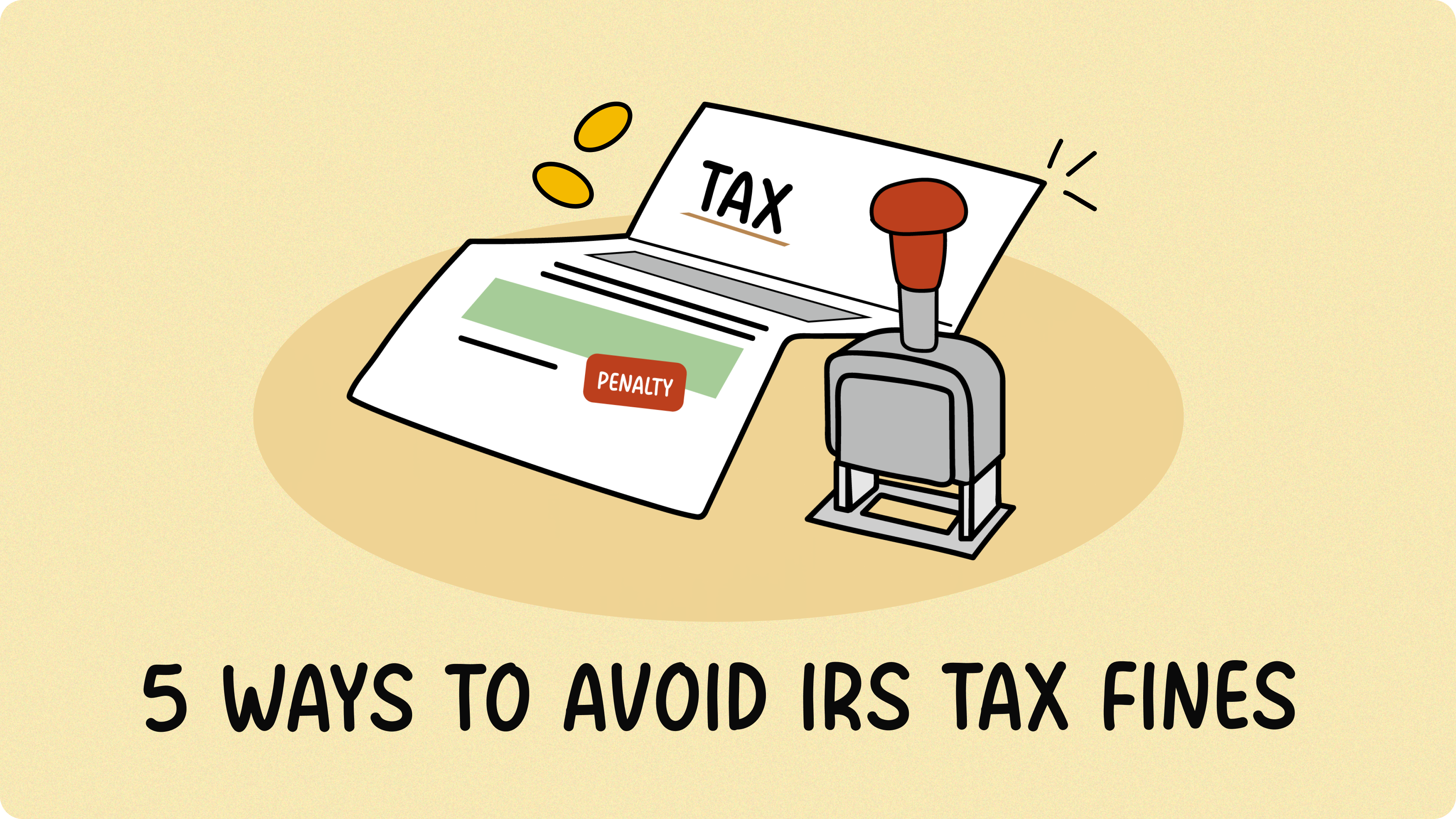We all love the freedom and flexibility that comes with being our own boss, but at the same time, the thought of the IRS lurking can create a sense of unease.
The good news is, with a little foresight and smart planning, you can drastically reduce your chances of incurring those pesky penalties.
According to New York Post, the IRS levied $7 billion in tax penalties in 2023, so you’re not alone if you’ve ever felt the sting. But for freelancers and small business owners, these fines can hit particularly hard.
Say no to tax fines, and don’t let the IRS ding your wallet. Let’s dive into 5 practical strategies to keep your hard-earned cash safe from the penalty box.
Table of Contents
- 1. Master Estimated Taxes
- 2. File On Time, Every Time
- 3. Keep Impeccable Records
- 4. Report All Your Income
- 5. Know Your Relief Options
1. Master Estimated Taxes
For most freelancers and small business owners, your income isn’t subject to traditional W-2 withholding. That means you’re responsible for paying your income and self-employment taxes throughout the year via estimated tax payments. To avoid underpayment penalties, the IRS requires you to pay either:
- 90% of your current year’s tax liability, or
- 100% of your prior year’s tax liability (110% if your prior year’s Adjusted Gross Income exceeded $150,000).
These are known as “safe harbor” rules.
Key Information:
- When to Pay: Estimated taxes are typically due quarterly: April 15, June 15, September 15, and January 15 of the following year. Mark these dates on your calendar and set multiple reminders!
- How to Calculate: It can feel like a guessing game, especially if your income fluctuates. Use IRS Form 1040-ES to help estimate your tax liability. Try basing it on your previous year’s income or projecting your current year’s earnings as accurately as possible. You may also consider using accounting software with it.
- The Cost of Not Paying Enough: The underpayment penalty interest rate is determined quarterly. For instance, the rate was 8% in Q4 2024 and adjusted to 7% in Q1 2025. This might seem small, but it adds up.
- If your income is highly unpredictable, consider adjusting your payments throughout the year. If you have a particularly good quarter, increase your estimated payment to avoid a shortfall later.
2. File On Time, Every Time
This might sound obvious, but the “failure to file” penalty is one of the most common fines issued by the IRS. The failure-to-file penalty is 5% of the unpaid taxes for each month or part of a month your return is late, up to a maximum of 25%.
Key Information:
- File an Extension: If you need more time to prepare your return, always file Form 4868, Application for Automatic Extension of Time to File U.S. Individual Income Tax Return, by the original deadline. This grants you an automatic six-month extension to file, usually until October 15.
- An Extension to File, Not to Pay: Crucially, an extension to file is NOT an extension to pay. You still need to pay any estimated taxes you owe by the original deadline to avoid the “failure to pay” penalty.
- Combined Penalties: If you both file late and pay late, the IRS will generally charge both penalties, though the failure-to-file penalty is reduced by the failure-to-pay penalty for any month they overlap. Still, it’s a double hit you want to avoid.
3. Keep Impeccable Records
Think of good record-keeping as your indispensable safety net. The IRS relies on accurate information, and if your numbers don’t add up, or if you can’t back up your deductions, you’re inviting trouble. Self-employed individuals, particularly those filing Schedule C, face heightened scrutiny and are more likely to be audited.
An audit can be triggered by seemingly simple things like math errors, disproportionately high deductions compared to your income, or a mismatch between what you report and what third parties (like clients issuing 1099s) report to the IRS. In fact, underreporting your income by more than 25% can extend the IRS’s audit window to six years.
What to keep track of:
- All Income: Every penny earned, from client payments to side gigs.
- All Expenses: Categorize everything business-related: home office costs (if applicable and exclusively used for business), supplies, software, travel, professional development, and so on.
- Receipts and Invoices: Digital or physical, keep them organized. For business use of a vehicle, for instance, detailed mileage logs are crucial.
- Bank Statements: Reconcile your business accounts regularly. ndividual taxpayers is low, at about 0.44% in 2023, corporate returns face a higher audit rate of 0.74%.
4. Report All Your Income
This is a big one for freelancers. The IRS receives copies of 1099-NEC forms from clients who paid you $600 or more. Failing to report this income can trigger audits and penalties. The IRS computer systems automatically compare the information they receive with what you report on your return.
Key Information:
- Beyond 1099s: Even if a client doesn’t issue a 1099 (e.g., if you earned less than $600 from them), you are still legally obligated to report that income.
- Cryptocurrency, Gambling, etc.: Don’t forget other sources of income like cryptocurrency gains, investment earnings, or even gambling winnings. All taxable income must be reported.
- Accuracy-Related Penalties: Understating your income significantly or claiming deductions/credits you’re not entitled to can lead to an accuracy-related penalty, which is typically 20% of the underpaid tax.
5. Know Your Relief Options
Life happens, and sometimes, despite your best efforts, you might miss a deadline or make a mistake. The IRS isn’t entirely without mercy, and they do offer penalty relief options.
- First-Time Penalty Abatement (FTA): If you have a clean compliance history (no penalties in the past three years), have filed all required returns, and have paid or arranged to pay any taxes owed, you might qualify for FTA. This is often the easiest path to getting a penalty removed.
- Reasonable Cause: If you can demonstrate that your failure to file or pay was due to reasonable cause and not willful neglect, the IRS may waive the penalty. Examples include serious illness, natural disasters, or unavoidable absence. You’ll need to provide supporting documentation.
- Payment Plans: If you can’t pay your full tax bill, contact the IRS to set up a payment plan, such as an installment agreement. This can prevent additional penalties from accumulating and reduce the failure-to-pay penalty to 0.25% per month while the plan is in effect.
- Seek Professional Help: Tax laws are complex, and they change. Don’t hesitate to consult a qualified tax professional (CPA, enrolled agent, or tax attorney). They can help ensure accuracy, identify all eligible deductions, and even negotiate with the IRS on your behalf if you face penalties or an audit. Many small business owners find the investment in professional tax guidance pays for itself by preventing costly errors and maximizing legitimate deductions.
By taking these proactive steps and staying organized, freelancers and small business owners can navigate the tax landscape with confidence, avoiding unnecessary fines and keeping more of their hard-earned money where it belongs: in your pocket, fueling your entrepreneurial journey!
Need assistance with your accounting or bookkeeping? Fynlo offers professional services tailored for your business. Schedule a call with us to see how we can simplify your financial life.
Further Reading
Continue your learning journey with these related accounting insights:







